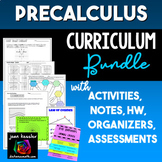Parametric, Polar, and Vector Functions Unit 6 Bundle PreCalculus
- Zip
- Easel Activity
Products in this Bundle (18)
showing 1-5 of 18 products
Also included in
- This PreCalculus Curriculum Bundle with Notes, Organizers, and Activities, includes over 130 Resources which will enhance your lessons and engage your students with rigorous, challenging and fun lessons. It will also supplement your AP PreCalculus course. If you need help organizing the activitiesPrice $345.00Original Price $523.70Save $178.70
Description
What's included in this unit bundle?
- This Applications of Trigonometry: Polar, Parametric, and Vector Functions bundle is teeming 18 activities with over 250 pages of resources including Task Cards, Guided Notes, Mazes, Graphic Organizers, Matching, Foldables, PowerPoints, Homework, Assessments, Graphing Calculator notes, and practice. The variety of resources and activities will keep your students engaged and learning throughout this important unit. These resources will also supplement your AP PreCalculus Course Units 3 and 4.
Note: This bundle does not include any Digital Products (except for the Unit Assessment in Digital and Print) or FUN Notes but I will gladly bundle some up for you. Email me for details.
- Applications of Trigonometry Part 2 - Polar, Parametric, and Vectors Digital Activity Bundle
- Digital Activities for PreCalculus and Trigonometry
- PreCalculus FUN Notes, complete notes in a fun format
____________________________________________________________
You may also like:
- Applications of Trigonometry Part 2 - Polar, Parametric, and Vectors Digital Activity Bundle
- PreCalculus FUN Notes, complete notes in a fun format
- Unit 7 Systems of Equations Unit Bundle
- More PreCalculus Activity Bundles
- Amazingly Easy Parametric Interactive ynamic Grapher with free software
- PreCalculus and Trig Digital Activities
- Free Polar Graph Paper plus Guided Notes
__________________________________________________
⇒ Click here to follow my TpT store to hear about my freebies, sales, and new products. Did you know that you can earn 5% back towards future purchases by leaving feedback? Your feedback is greatly appreciated.
If you have any questions or comments please contact me by email me at: joan@joansworldofmath.com.
Connect with me:
✓ Sign up at Joan's World of Math to access my exclusive Free Resource Library, and get news and updates.
✓ Visit my Facebook Page
✓ Follow me on Instagram
LICENSING TERMS: The purchase of a license for this resource is for use by one teacher only for his or her students only. No part of this resource is to be shared with colleagues or used by an entire department, school, or district without purchasing the proper number of licenses. Please respect my hard work and do not share.
COPYRIGHT TERMS: ©2023 Joan Kessler (joansworldofmath™). This resource may not be uploaded to the internet in any form, including classroom/personal websites or network drives, unless the site is password protected and can only be accessed by students.
AP® is a registered trademark of the College Board® which was not involved in the creation of this product and does not endorse this product nor any that are linked on this page.





